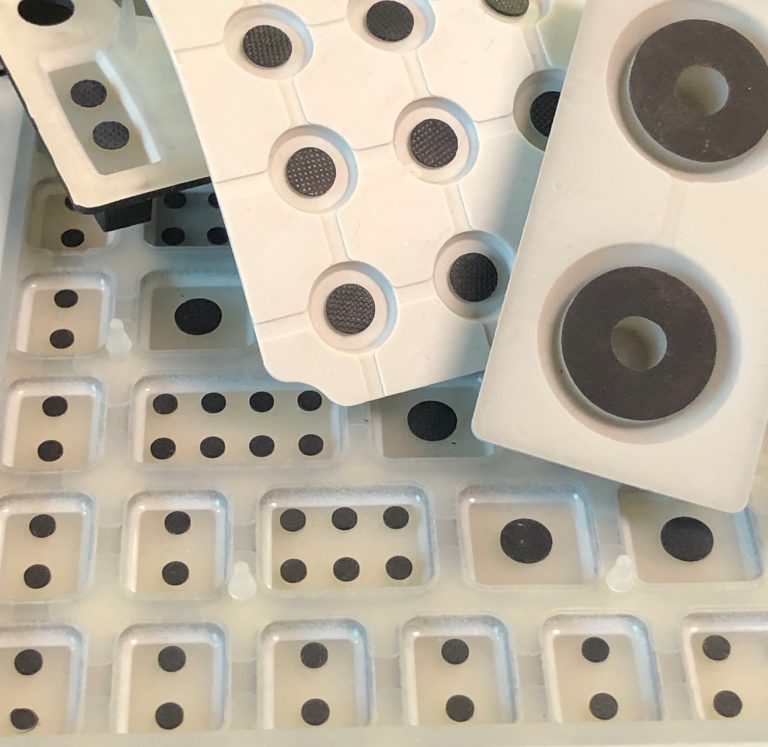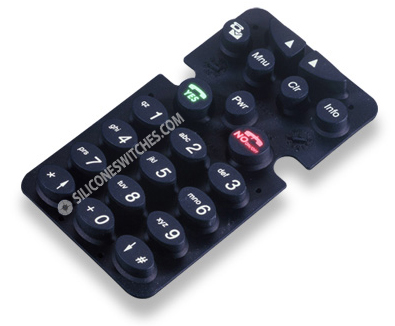Why silicone is the material of choice for most Rubber Keypads
Wiki Article
A Comprehensive Guide to the Production and Processing of Rubber Keypads for Optimal Performance
The production and handling of rubber keypads play a necessary duty in their performance and use. Material choice, design accuracy, and advanced manufacturing strategies significantly impact their sturdiness and effectiveness. Understanding these components is essential for creating high-grade products. As different advancements emerge in this area, exploring their effects could reveal brand-new standards for performance and individual experience. What key facets will shape the future of rubber keypads?Comprehending Rubber Keypads: Products and Types
Rubber keypads are important components in countless gadgets, offering an equilibrium of durability and responsive comments. These keypads are largely made from silicone or synthetic rubber, materials selected for their flexibility and resilience. Silicone rubber, specifically, is favored for its excellent temperature resistance and long life, making it optimal for different applications, from consumer electronic devices to commercial machinery.There are numerous sorts of rubber keypads, consisting of dome switch keypads, which use a dome-shaped mechanism that supplies tactile feedback when pressed. In addition, there are also flat keypads, which include a smooth surface and are frequently made use of in clinical devices and remote controls. The choice of product and type influences the keypad's performance, really feel, and total customer experience. Comprehending these facets is vital for makers and developers intending to develop reliable and effective interfaces in their products.
The Manufacturing Refine: From Design to Production
The production procedure of rubber keypads includes several essential phases, beginning with style and ending with production. At first, developers develop comprehensive requirements and models, assuring the keypad meets functional and aesthetic requirements. Computer-aided layout (CAD) software is usually made use of to picture the format and functions before proceeding.When the style is settled, product choice is important, with options generally consisting of silicone or natural rubber. In the following stage, molds are created based upon the authorized designs, which will certainly shape the keypads throughout production.
Following mold and mildew creation, the manufacturing phase starts, where rubber is combined with additives to enhance performance. The mix is after that poured into mold and mildews and subjected to warm and pressure, allowing it to strengthen and cure.
Ultimately, the ended up keypads go through high quality checks to validate they meet established criteria, followed by packaging for circulation. This all-encompassing procedure guarantees peak efficiency in the final product.
Secret Techniques in Rubber Molding
In the domain of rubber keypads, different molding strategies play a pivotal role in figuring out the high quality and performance of the end product. One common method is compression molding, where raw rubber is positioned in a heated mold and stress is used, allowing for effective mass manufacturing and uniformity. One more considerable strategy is injection molding, which includes injecting warmed rubber into a mold, providing greater precision and facility shapes. Transfer molding, a hybrid of both techniques, is also made use of, especially for intricate styles, as it combines the advantages of both procedures. Furthermore, fluid silicone rubber (LSR) molding is getting traction due to its adaptability and durability, making it optimal for high-performance applications. Each technique has special qualities, influencing variables such as cycle time, material waste, and manufacturing expenses. Picking the appropriate molding method is important for attaining peak performance in rubber keypads.Surface Area Finishing and Texturing Options
Surface area completing and texturing alternatives play a vital function in boosting the responsive experience and aesthetic charm of rubber keypads. Suppliers use numerous strategies to produce distinct surface attributes that impact user interaction and product style. Typical completing methods include matte, shiny, and satin coatings, each using various visual results and grip levels. Texturing alternatives, such as increased patterns, grooves, or stippling, additionally improve capability by enhancing traction and lowering slippage throughout use.Additionally, certain structures can be tailored to meet ergonomic demands, giving comfort during prolonged use. The selection of surface coatings and appearances can be affected by the intended application of the keypad, whether it be for customer electronics, automotive controls, or commercial tools. Inevitably, careful factor to consider of these options contributes significantly to user contentment and total product performance, making them critical elements in the layout and manufacturing process of rubber keypads.
Top Quality Control Steps in Rubber Keypad Production
Quality control actions in rubber keypad manufacturing are vital for making certain product integrity and performance. These measures include material option standards, extensive testing treatments, and rigorous final evaluation criteria. Together, they create a comprehensive framework that aids manufacturers support high quality throughout the manufacturing procedure.
Material Choice Standards
Choosing the ideal products for rubber keypads is essential, as it straight affects their individual, resilience, and functionality experience. Trick criteria for product selection consist of tensile toughness, durability, and ecological resistance. The selection of rubber compound, such as silicone or polycarbonate elastomer (TPE), plays a vital function in achieving desired tactile comments and long life. Furthermore, factors like chemical compatibility, temperature level security, and UV resistance should be considered to ensure optimal efficiency in different applications. Makers should additionally review the simplicity of processing and cost-effectiveness of materials, stabilizing quality with budget constraints. Eventually, the best product option not only improves the keypad's performance but also adds to total item top quality and consumer satisfaction.Evaluating Procedures Applied
After determining the proper products for rubber keypads, rigorous screening treatments are have a peek at this site executed to confirm that the end products meet industry criteria and consumer expectations. These treatments normally include mechanical screening, which examines the durability and flexibility of the rubber under numerous conditions. Additionally, ecological testing analyzes the keypads' efficiency under temperature fluctuations, humidity, and exposure to chemicals. Electrical screening validates the keypads work correctly with digital elements, verifying responsiveness and conductivity. Furthermore, tactile responses is reviewed to guarantee individual fulfillment. These substantial screening steps are necessary in identifying any type of disparities or flaws before automation, eventually improving the dependability and performance of rubber keypads in their desired applications.
Last Assessment Requirements
Extensive last evaluation standards are crucial in rubber keypad manufacturing to guarantee that each unit fulfills the specified requirements for performance and appearance. This procedure generally includes aesthetic analyses to determine any kind of surface flaws, such as staining or flaws. In addition, tactile examinations ascertain that the keypads react accurately to touch, maintaining the needed level of level of sensitivity. Toughness examinations may also be conducted, mimicing extended usage to confirm the durability of the keypad under various conditions. In addition, adherence to market regulations and client specifications is validated to keep quality guarantee. By executing more information these extensive inspection steps, manufacturers can considerably lower the threat of defects, making sure that the final product is trustworthy and meets consumer expectations, ultimately boosting consumer contentment.Technologies in Rubber Keypad Technology
As innovation continues to progress, developments in rubber keypad technology are improving user interfaces throughout numerous markets. One considerable innovation is the combination of capacitive touch sensors within rubber keypads, permitting an extra functional and responsive user experience. This innovation enables users to communicate with tools via touch, enhancing capability without compromising the responsive comments that rubber keypads are known for.Furthermore, renovations in material formulas have led to the growth of more sturdy, weather-resistant rubber, making keypads ideal for commercial and outdoor use. Boosted printing methods also permit for high-resolution graphics and backlighting options, boosting visibility and aesthetic allure.

Advancements in manufacturing processes, such as 3D printing, are enabling custom styles and quick prototyping, streamlining production timelines. These developments jointly add to a lot more user-friendly and effective rubber keypads, guaranteeing they fulfill the needs of modern applications while preserving their core advantages.
Best Practices for Design and Performance
Creating effective rubber keypads calls for careful evaluation of both appearances and functionality. Rubber Keypads. A well-designed keypad should stabilize ergonomic principles with visual interest improve user experience. Secret factors consist of size, form, and spacing of buttons, guaranteeing they are simple to press while protecting against unintentional activation. Utilizing contrasting shades and textures can boost visibility and tactile feedback, helping users in comparing secretsIn addition, the choice of products plays a vital role; top quality rubber compounds can boost durability and resistance to put on. It is likewise important to consider the assimilation of features such as backlighting and personalized graphics, which can improve usability in various settings.
Prototyping and user screening are indispensable in the style process, permitting for modifications based on real-world comments. By adhering to these best practices, producers can create rubber keypads that not just look appealing yet also satisfy the functional demands of individuals efficiently.
Often Asked Concerns
Exactly how Do I Choose the Right Rubber Material for My Keypad?
To pick the ideal rubber product for a keypad, one must think about variables such as toughness, environmental resistance, responsive feedback, and compatibility with the intended application, ensuring excellent performance and individual fulfillment in different problems.What Are the Ecological Effects of Rubber Keypad Manufacturing?
Rubber keypad production can bring about ecological effects such as logging for all-natural rubber resources, air pollution from chemical processes, and waste generation. Lasting practices and products can reduce some of these unfavorable impacts on ecosystems.Can Rubber Keypads Be Recycled or Recycled?
have a peek at these guys Rubber keypads can be reused, however the procedure depends on the certain materials used in their manufacturing. Reusing them in different applications is also feasible, adding to throw away reduction and advertising sustainability in manufacturing practices.What Is the Typical Life Expectancy of a Rubber Keypad?
The ordinary life expectancy of a rubber keypad normally ranges from 5 to one decade, depending on use, ecological aspects, and upkeep. Normal care can prolong its performance, while extreme wear may reduce its toughness.Exist Any Type Of Wellness Issues Associated to Rubber Keypad Materials?
There are possible health and wellness problems connected to rubber keypad products, consisting of allergies to certain chemicals and irritants used in production. Proper handling and understanding of product composition can alleviate these dangers for individuals.There are a number of kinds of rubber keypads, including dome button keypads, which use a dome-shaped system that provides responsive responses when pressed. Choosing the ideal products for rubber keypads is vital, as it directly affects their user, performance, and durability experience - Rubber Keypads. After identifying the suitable materials for rubber keypads, strenuous testing treatments are applied to confirm that the last items meet market criteria and client expectations. Rubber keypad production can lead to environmental effects such as logging for natural rubber resources, contamination from chemical procedures, and waste generation. Rubber keypads can be recycled, however the process depends on the specific products used in their production
Report this wiki page